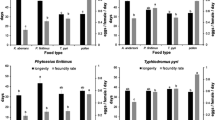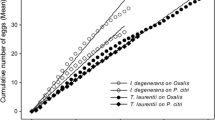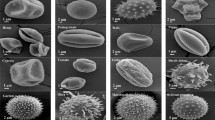Abstract
Biological parameters, prey consumption and prey conversion into egg biomass of overwintered females of the phytoseiids Kampimodromus aberrans, Amblyseius andersoni and Typhlodromus pyri fed with varying numbers of Eotetranychus carpini females or pollen were studied in the laboratory. We found that pollen and E. carpini females proved to be optimal foods for overwintered phytoseiids. In most comparisons pollen induced performances comparable to those recorded when predatory mites were supplied with 4–8 prey per day. Typhlodromus pyri and A. andersoni females survived longer when fed on pollen and the percentage of K. aberrans ovipositing females was higher with pollen than with spider mite prey. For K. aberrans and T. pyri, periods to diapause termination were comparable when pollen or eight prey per predator per day were provided. Oviposition times were long for T. pyri and A. andersoni fed with pollen. Low numbers (1–2) of E. carpini drastically reduced predatory mite oviposition, particularly in A. andersoni that showed high requirements in terms of food biomass. Results highlighted the importance of pollen for overwintered predatory mites. The results obtained can help in understanding some aspects of the biology and behaviour of the three predatory mites in vineyards.




Similar content being viewed by others
References
Bermúdez P, Vargas R, Cardemil A, López E (2010) Effect of pollen from different plant species on development of Typhlodromus pyri (Scheuten) (Acari: Phytoseiidae). Chil J Agric Res 70:408–416
Boller EF, Frey B (1990) Blühende rebberge in der Ostschweiz: 1. Zur bedeutung des pollens für die raubmilben. Schweiz Zeit Obst-Weinbau 126:401–405
Boller EF, Remund U, Candolfi MP (1988) Hedges as potential sources of Typhlodromus pyri, the most important predatory mite in vineyards of northern Switzerland. Entomophaga 33:249–255
Bouras SL, Papadoulis GT (2005) Influence of selected fruit tree pollen on life history of Euseius stipulatus (Acari: Phytoseiidae). Exp Appl Acarol 36:1–14
Broufas GD (2001) Diapause induction and termination in the predatory mite Euseius finlandicus in peach orchards in northern Greece. Exp Appl Acarol 25:921–932
Broufas GD, Pappas ML, Koveos DS (2006) Effect of cold exposure and photoperiod on diapause termination of the predatory mite Euseius finlandicus (Acari: Phytoseiidae). Environ Entomol 35:1216–1221
Dicke M, Sabelis MW, De Jong M (1988) Analysis of prey preference in phytoseiid mites by using an olfactometer, predation models and electrophoresis. Exp Appl Acarol 5:225–241
Dosse G (1961) Über die bedeutung der pollennahrung für Typhlodromus pyri Scheuten (=tiliae Oud.) (Acari: Phytoseiidae). Entomol Exp Appl 4:191–195
Duso C (1989) Role of the predatory mites Amblyseius aberrans (Oud.), Typhlodromus pyri Scheuten and Amblyseius andersoni (Chant) (Acari, Phytoseiidae) in vineyards. I. The effects of single or mixed phytoseiid population releases on spider mite densities (Acari, Tetranychidae). J Appl Entomol 107:474–492
Duso C (1990) Indagini sulla biologia, l’ecologia ed il comportamento degli acari predatori Amblyseius aberrans (Oud.), Typhlodromus pyri Scheuten e Amblyseius andersoni (Chant) (Acari, Phytoseiidae). Ph.D Thesis University of Bologna, Bologna, Italy
Duso C, Camporese P (1991) Developmental times and oviposition rates of predatory mites Typhlodromus pyri and Amblyseius andersoni (Acari, Phytoseiidae) reared on different foods. Exp Appl Acarol 13:117–128
Duso C, Pasqualetto C (1993) Factors affecting the potential of phytoseiid mites (Acari: Phytoseiidae) as biocontrol agents in North-Italian vineyards. Exp Appl Acarol 17:241–258
Duso C, Vettorazzo E (1999) Mite population dynamics on different grape varieties with or without phytoseiids released (Acari: Phytoseiidae). Exp Appl Acarol 23:741–763
Duso C, Pasqualetto C, Camporese P (1991) Role of the predatory mites Amblyseius aberrans (Oud.), Typhlodromus pyri Scheuten and Amblyseius andersoni (Chant) (Acari, Phytoseiidae) in vineyards. II. Minimum releases of A. aberrans and T. pyri to control spider mite populations (Acari, Tetranychidae). J Appl Entomol 112:298–308
Duso C, Malagnini V, Paganelli A (1997) Indagini preliminari sul rapporto tra polline e Kampimodromus aberrans (Acari: Phytoseiidae) su Vitis vinifera L. Allionia 35:229–239
Duso C, Pozzebon A, Capuzzo C, Bisol PM, Otto S (2003) Grape downy mildew spread and mite seasonal abundance in vineyards: evidence for the predatory mites Amblyseius andersoni and Typhlodromus pyri. Biol Control 27:229–241
Duso C, Malagnini V, Paganelli A, Aldegheri L, Bottini M, Otto S (2004) Pollen availability and abundance of predatory phytoseiid mites on natural and secondary hedgerows. BioControl 49:397–415
Duso C, Fanti M, Pozzebon A, Angeli G (2009) Is the predatory mite Kampimodromus aberrans a candidate for the control of phytophagous mites in European apple orchards? BioControl 54:369–382
Duso C, Pozzebon A, Kreiter S, Tixier MS, Candolfi MP (2012) Management of phytophagous mites in European vineyards. In: Bostanian NJ, Vincent C, Isaacs R (eds) Arthropod management in vineyards: pests, approaches, and future directions. Springer, Dordrecht, pp 191–217
Engel R, Ohnesorge B (1994a) Die rolle von ersatznahrung und mikroklima im system Typhlodromus pyri Scheuten (Acari, Phytoseiidae)—Panonychus ulmi Koch (Acari, Tetranychidae) auf weinreben I. Untersuchungen im labor. J Appl Entomol 118:129–150
Engel R, Ohnesorge B (1994b) Die rolle von ersatznahrung und mikroklima im system Typhlodromus pyri Scheuten (Acari, Phytoseiidae)—Panonychus ulmi Koch (Acari, Tetranychidae) auf weinreben I. Freilandversuche. J Appl Entomol 118:224–238
Ivancich Gambaro P (1973) Il ruolo del Typhlodromus aberrans Oudemans (Acarina Phytoseiidae) nel controllo biologico degli acari fitofagi del Veronese. Boll Zool Agr Bachic 11:151–165
Kasap I (2005) Life-history traits of predaceous mites Kampimodromus aberrans (Oudemans) (Acarina: Phytoseiidae) on four different types of food. Biol Control 35:40–45
Kasap I, Atlihan R (2011) Consumption rate and functional response of the predaceous mite Kampimodromus aberrans to two-spotted spider mite Tetranychus urticae in the laboratory. Exp Appl Acarol 53:253–261
Kim SY, Lee J, Jung C (2010) The effect of temperature and light conditions on diapause induction in a Korean population of Neoseiulus womersleyi Schicha (Acari: Phytoseiidae). J Asia-Pacific Entomol 13:127–130
Koveos DS, Broufas GD (2000) Functional response of Euseius finlandicus and Amblyseius andersoni to Panonychus ulmi on apple and peach leaves in the laboratory. Exp Appl Acarol 24:247–256
Kreiter S, Tixier MS, Auger P, Muckensturm N, Sentenac G, Doublet B, Weber M (2000) Phytoseiid mites of vineyards in France (Acari: Phytoseiidae). Acarologia 61:77–96
Lester PJ, Harmsen R (2002) Functional and numerical responses do not always indicate the most effective predator for biological control: an analysis of two predators in a two-prey system. J Appl Ecol 39:455–468
Lorenzon M, Pozzebon A, Duso C (2012) Effects of potential food sources on biological and demographic parameters of the predatory mites Kampimodromus aberrans, Typhlodromus pyri and Amblyseius andersoni. Exp Appl Acarol 58:259–278
McMurtry JA, Croft BA (1997) Life-styles of phytoseiid mites and their role in biological control. Annu Rev Entomol 42:291–321
McMurtry JA, De Moraes GJ, Sourassou UF (2013) Revision of the lifestyles of phytoseiid mites (Acari: Phytoseiidae) and implications for biological control strategies. System App Acarol 18:297–320
Overmeer WPJ (1985) Diapause. In: Helle W, Sabelis MW (eds) Spider mites: their biology, natural enemies and control, world crop pests, vol 1B. Elsevier, Amsterdam, pp 95–102
Pozzebon A, Loeb GM, Duso C (2009) Grape powdery mildew as a food source for generalist predatory mites occurring in vineyards: effects on life-history traits. Ann Appl Biol 155:81–89
Pozzebon A, Ahmad S, Tirello P, Lorenzon M, Duso C (2014) Does pollen availability mitigate the impact of pesticides on generalist predatory mites? BioControl 59:585–596
Schruft G (1985) Grape. In: Helle W, Sabelis MW (eds) Spider mites: their biology, natural enemies and control, world crop pests, vol 1B. Elsevier, Amsterdam, pp 359–365
Tixier MS, Baldassar A, Duso C, Kreiter S (2013) Phytoseiidae in European grape (Vitis vinifera L.): bio-ecological aspects and keys to species (Acari: Mesostigmata). Zootaxa 3721:101–142
Veerman A (1992) Diapause in phytoseiid mites: a review. Exp Appl Acarol 14:1–60
Wiedmer U, Boller E (1990) Bluhende rebberge in der Ostschweiz: 2. Zum pollenangebot auf den rebenblattern. Schweiz Z Obst-Weinbau 126:426–431
Zemek R (1993) Characteristics of development and reproduction in Typhlodromus pyri on Tetranychus urticae and Cecidophyopsis ribis. I. Overwintered females. Exp Appl Acarol 17:405–421
Acknowledgments
We wish to thank the Province of Treviso for providing a grant to M. Lorenzon in the framework of the Doctoral School in Viticulture and Oenology, University of Padua, Italy. We thank Paola Tirello (University of Padua) for assistance during the study. We thank Patrick De Clercq and two anonymous reviewers for comments that improved the manuscript.
Author information
Authors and Affiliations
Corresponding author
Additional information
Handling Editor: Patrick De Clercq.
Rights and permissions
About this article
Cite this article
Lorenzon, M., Pozzebon, A. & Duso, C. Feeding habits of overwintered predatory mites inhabiting European vineyards. BioControl 60, 605–615 (2015). https://doi.org/10.1007/s10526-015-9679-y
Received:
Accepted:
Published:
Issue Date:
DOI: https://doi.org/10.1007/s10526-015-9679-y




